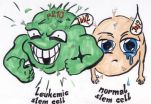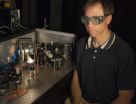Can narcissists be moved to show empathy?
2014-05-30
(Press-News.org) Researchers at the University of Surrey and the University of Southampton have investigated whether narcissists can elicit empathy for another person's suffering. It has been well documented that narcissists lack empathy, but why is that the case, and do they have the capacity to change that behavior? The research is published in Personality and Social Psychology Bulletin.
Characterizing narcissism
When we think of narcissism most of us can all think of a colleague, friend, or former significant other that would fit the description; "A bit full of themselves, self-centered, and don't seem too concerned about the effects they have on other people," says lead researcher, Erica Hepper. This lack of empathy has a detrimental effect on interpersonal relationships, social bonding and prosocial behavior.
For the purposes of this research, the researchers focused on individuals who exhibit subclinical narcissism, rather than a clinical diagnosis of narcissistic personality disorder (NPD). Dr. Hepper explains that this distinction was made because "people high in subclinical narcissism are psychologically healthy and well-adjusted, often even very successful, whereas people with NPD are inflexible and volatile, and don't manage day-to-day life well." Subclinical narcissism is also more common, and the number of people exhibiting narcissistic traits in our society continues to increase. The participants were broken down into two categories, 'low narcissists' and 'high narcissists,' which identifies participants as being less narcissistic or more narcissistic than the average person.
Results of the research
The researchers examined whether narcissists are capable of empathizing with another person in distress by having participants read a vignette describing a recent relationship break-up. Regardless of how mild or severe the scenario was, high-narcissists did not show empathy for the subject. The results pinpoint the role of narcissism as driven by its maladaptive components such as entitlement, exploitativeness and exhibitionism. Furthermore, narcissists lacked empathy even when the scenario was relatively severe (i.e., the subject was overwhelmed with depression).
The researchers then tested whether narcissists are capable of showing empathy when they are instructed to take the perspective of the target person. Female participants were shown a 10-minute documentary describing a woman's experience with domestic violence. Participants were prompted to "imagine how she feels" while watching the video. Low-narcissists were unaffected by the cognitive-perspective taking, implying they were already taking the woman's perspective. High-narcissists reported significantly higher empathy for the woman in the video when they had been instructed to take her perspective, versus not being prompted with that suggestion.
Lastly, the researchers tested whether narcissists can be moved, not just emotionally, but also physiologically. Previous studies have shown that increases in heart rate reliably indicate empathetic response to another's emotions or suffering. High-narcissists had a significantly lower heart rate when exposed to a target character's distress, illustrating that their lack of empathy is also physiological. However, perspective-taking led high-narcissists to respond to another's distress with the same level of autonomic arousal as low-narcissists.
The findings suggest that narcissists do have the capacity to empathize with other people's needs given the right conditions. "If we encourage narcissists to consider the situation from their teammate or friend's point of view, they are likely to respond in a much more considerate or sympathetic way," Dr. Hepper says. This is an encouraging result and suggests that relatively anti-social members of society can be empathetic, which would improve their long-term relationships.
Dr. Hepper is extending this research to on-line social interactions and ongoing relationships, in an effort to observe whether narcissists can respond in an empathetic way when speaking with someone who is distressed, or with existing friends and romantic partners.
INFORMATION:
Please email press@spsp.org if you would like a copy of the original study in Personality and Social Psychology Bulletin.
Hepper, E. G., Hart, C. M., and Sedikides, C. (2014). Moving Narcissus: Can Narcissists Be Empathic?. Personality and Social Psychology Bulletin, 40(8). [Insert URL from SAGE]
Personality and Social Psychology Bulletin (PSPB), published monthly, is an official journal of the Society of Personality and Social Psychology (SPSP). SPSP promotes scientific research that explores how people think, behave, feel, and interact. The Society is the largest organization of social and personality psychologists in the world. Follow us on Twitter, @SPSPnews and find us at facebook.com/SPSP.org
ELSE PRESS RELEASES FROM THIS DATE:
Narcissists can feel empathy, research finds
2014-05-30
Narcissists tend to lack empathy, which can cause problems for themselves, the people around them and society in general. However, new research published today from the University of Surrey, suggests that with the right focus, people with narcissistic tendencies can feel empathy for another person's suffering. This may be important in helping to prevent the often violent or anti-social behaviours that some narcissists are prone to and the crimes that are committed as a result.
The research, published in Personality and Social Psychology Bulletin, studied participants ...
Eating prunes can help weight loss
2014-05-30
Research by the University of Liverpool has found that eating prunes as part of a weight control diet can improve weight loss.
Consumption of dried fruit is not readily recommended during weight loss despite evidence it enhances feelings of fullness.
However, a study by the University's Institute of Psychology, Health and Society of 100 overweight and obese low fibre consumers tested whether eating prunes as part of a weight loss diet helped or hindered weight control over a 12-week period.
It also examined if low fibre consumers could tolerate eating substantial ...
Cochrane review on use of rectal artesunate for severe malaria
2014-05-30
Researchers from the Cochrane Infectious Diseases Group, hosted at LSTM, conducted an independent review of the effects of pre-referral rectal artesunate for people with severe malaria, published in the Cochrane Library today. The review follows a large trial of rectal artesunate in 2009 which led the World Health Organization to recommend its use.
Severe malaria is a serious medical condition caused by infection with the Plasmodium parasite. It is treated by giving injections of antimalarial drugs, which need to be started as quickly as possible to reduce the risk of ...
One cell's meat is another cell's poison
2014-05-30
As a new therapeutic approach, Janus kinases are currently in the limelight of cancer research. The focus of interest is the protein JAK2. By inhibiting this protein one tries to cure chronic bone marrow diseases, such as myelofibrosis and chronic myeloid leukemia (CML).
Loss of JAK2 is advantageous for leukemia cells
Scientists working with Veronika Sexl at the Institute of Pharmacology and Toxicology may initiate a transformation of thought in regard of JAK2 inhibition. To simulate the human disease as accurately as possible, the scientists used a mouse leukemia ...
Chinese scientists map reproductive system's evolution as dinosaurs gave rise to birds
2014-05-30
As winged dinosaurs underwent a series of evolutionary changes during the transition into Aves, or birds, one pivotal transformation was the appearance of a single-ovary reproductive system. "The most widely accepted hypothesis for the presence of a single functional ovary in living birds is that the right ovary … was lost to reduce body mass in gravid females during flight," report a team of Chinese scientists who are adding new details to the mosaic of understanding how terrestrial dinosaurs gave rise to birds and powered flight.
These scientists, led by the director ...
Observing the random diffusion of missing atoms in graphene
2014-05-30
This news release is available in German. Imperfections in the regular atomic arrangements in crystals determine many of the properties of a material, and their diffusion is behind many microstructural changes in solids. However, imaging non-repeating atomic arrangements is difficult in conventional materials. Now, researchers at the University of Vienna have directly imaged the diffusion of a butterfly-shaped atomic defect in graphene, the recently discovered two-dimensional wonder material, over long image sequences. The results are published in the prestigious journal ...
Genome sequences show how lemurs fight infection
2014-05-30
DURHAM, N.C. -- The young lemur named Eugenius started to get sick. Very sick. He was lethargic, losing weight and suffering from diarrhea. Duke Lemur Center veterinarians soon pinpointed the cause of his illness: Eugenius tested positive for Cryptosporidium, a microscopic intestinal parasite known to affect people, pets, livestock and wildlife worldwide.
In humans, thousands of cases of Cryptosporidium are reported in the United States each year, spread primarily through contaminated water.
Since Eugenius was the first animal diagnosed in 1999, the parasite has caused ...
New printable robots could self-assemble when heated
2014-05-30
Printable robots — those that can be assembled from parts produced by 3-D printers — have long been a topic of research in the lab of Daniela Rus, the Andrew and Erna Viterbi Professor of Electrical Engineering and Computer Science at MIT.
At this year's IEEE International Conference on Robotics and Automation, Rus' group and its collaborators introduce a new wrinkle on the idea: bakable robots.
In two new papers, the researchers demonstrate the promise of printable robotic components that, when heated, automatically fold into prescribed three-dimensional configurations. ...
Radiation for prostate cancer linked to secondary cancers, study finds
2014-05-30
ANN ARBOR, Mich. — Among men treated for prostate cancer, those who received radiation therapy were more likely to develop bladder or rectal cancer, according to a new study from the University of Michigan Comprehensive Cancer Center.
"Overall the incidence of these cancers is low. But when men have received radiation treatments, it's important to evaluate carefully any symptoms that could be a sign of bladder or rectal cancer," says senior study author Kathleen A. Cooney, M.D., professor of hematology/oncology and urology at the U-M Medical School.
The study, which ...
Novel NIST laser system mimics sunlight to test solar cell efficiency
2014-05-30
Researchers at the National Institute of Standards and Technology (NIST) have developed a laser-based instrument that generates artificial sunlight to help test solar cell properties and find ways to boost their efficiency.
The novel NIST system simulates sunlight well across a broad spectrum of visible to infrared light. More flexible than conventional solar simulators such as xenon arc-lamps or light-emitting diodes, the laser instrument can be focused down to a small beam spot—with resolution approaching the theoretical limit—and shaped to match any desired spectral ...





